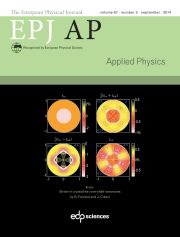No CrossRef data available.
Article contents
A preliminary discussion of Dulkyn interferometer
Published online by Cambridge University Press: 15 January 2000
Abstract
The Dulkyn interferometer in Kazan is an active ring laser where the lightpropagates along two different paths. It has been developed with the ideathat it could detect low frequency gravitational waves on Earth.Considering Dulkyn as a detector of periodic strains of order of h ~ 10−22 at low frequencies (10−3 Hz−10−5 Hz) wecalculate that 30 W is the order of magnitude of the optical powernecessary to beat the photon noise in the case of a long observation time (T = 4 months) and a reasonable signal to noise ratio (r = 3). We estimatethat the displacement noise of the mirrors must not exceed 5×10−19m/ $\sqrt{{Hz}}$  .Dulkyn is also sensitive to accelerations and rotations. The accelerationnoise does not seem to be troublesome ( $\widetilde{g}\lesssim 0.1{m}{s}^{-2}/\sqrt{{Hz}}$
.Dulkyn is also sensitive to accelerations and rotations. The accelerationnoise does not seem to be troublesome ( $\widetilde{g}\lesssim 0.1{m}{s}^{-2}/\sqrt{{Hz}}$  ), but the angular velocity noise must beless than 5×10−11 s−1/ $\sqrt{{Hz}}$
), but the angular velocity noise must beless than 5×10−11 s−1/ $\sqrt{{Hz}}$  . The maximum strain (10−22) is obtained with free (pendulous) mirrors.Out of resonance, the strain is many orders of magnitude smaller when themirrors are fixed on a rigid support. Such a case would rule out thepossibility of a detection. As a conclusion we emphasize that the Dulkyndesign does not bring any decisive improvement for the detection of lowfrequency gravitational waves on Earth.
. The maximum strain (10−22) is obtained with free (pendulous) mirrors.Out of resonance, the strain is many orders of magnitude smaller when themirrors are fixed on a rigid support. Such a case would rule out thepossibility of a detection. As a conclusion we emphasize that the Dulkyndesign does not bring any decisive improvement for the detection of lowfrequency gravitational waves on Earth.
Information
- Type
- Research Article
- Information
- Copyright
- © EDP Sciences, 2000

